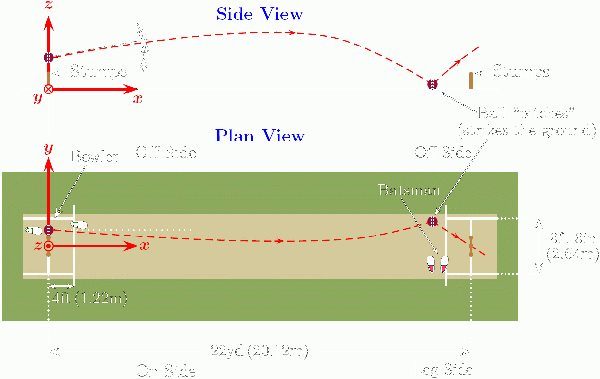While we are much more accustomed to hearing about physicists measuring the spin of electrons, protons and neutrons, Garry and Ian Robinson, honorary visiting fellows at the University of New South Wales and the University of Melbourne respectively, have decided to test physics in cricket. The duo has come up with equations concerning the path of a spinning ball in cricket as it moves through the wind. The Robinsons’ goal is to help spin-bowlers deliver top results and deceive a bats-person in the process.
Their paper is set to be published tomorrow in Physica Script. This journal is published by IOP Publishing on behalf of the Royal Swedish Academy of Sciences for the Science Academies and the Physical Societies of the Nordic Countries.
Their research would appear to be timely. Next week, the test cricket series that has been played between England and Australia biennially since 1882, will kick off in London, England.
England is the current holder after winning the Ashes in both the 2009 and 2010/11 series in England and Australia respectively.
If the English and Australian cricketers are looking do some extra preparation before the start of the Ashes, perhaps it would do no harm to take a look at the Robinsons’ research and do a spot of meteorological research to see what the wind patterns will be like next week in London.
The cricket players, it seems, could be hoping for some unpredictable British weather during the five-game series. Why? The two Australian researchers have calculated that wind can have a profound effect on the movement through the air of a spin-bowler’s delivery of a cricket ball.

One of the Robinsons’ equations. Image via Physica Scripta
Cross-winds and cricket
According to Garry and Ian Robinson, the presence of a cross-wind from either side of the cricket pitch can cause the spinning ball to either slightly ‘hold up’ or ‘dip’, depending on which direction the wind comes from, and which way the ball is spinning. This, therefore, changes the point at which the ball pitches on the wicket, they say.
“Our results show that the effects on a spinning ball are not purely due to the wind holding the ball up, since a reversal of wind direction can cause the ball to dip instead,” said Garry Robinson. “These trajectory changes are due to the combination of the wind and the spin of the ball.”
He said the effects of spin in the presence of a cross-wind, and how to fully exploit it, may or may not be “completely appreciated” by spin bowlers.
“Either way, we have provided a mathematical model for the situation, although the model of course awaits detailed comparison with observations,” he said.
As an example, the researchers detailed that when a 14 km/h cross-wind interacts with the spinning ball, the point at which it hits the ground can change by around 14 cm, which they believe may be enough to deceive a bats-person.
The Robinsons said their equations take into account the speed of the ball, gravity, the drag force caused by air resistance, and the Magnus or ‘lift’ force, while at the same time considering the “important” effect of wind.

One of the Robinsons’ equations. Image via Physica Scripta
What’s the Magnus force in ball sports?
The Magnus force is a commonly observed effect, particularly in ball sports, when the spin of a ball causes it to curve away from its set path.
In the game of football, for instance, this is observed when players purposely put spin on the ball to make it bend around a defensive wall.
Once the equations were constructed, the Robinsons numerically solved them using a computer software program called MATLAB. The solutions were then used to create illustrative examples for cricket.
The researchers also aim to depict that a spinning cricket ball tends to ‘drift’ in the latter stages of its flight as it descends, moving further to the off-side for an off-spinning delivery, and moving further towards the leg-side for a leg-spinning delivery. Apparently, in the game of cricket, these effects are well-known, with spin-bowlers regularly deploying them.
“We hope that this work can be used to cast new light on the motion of a spinning spherical object, particularly as applied to cricket, while also stirring the interests of students studying differential equations,” Robinson continued.
Cricket image via Shutterstock